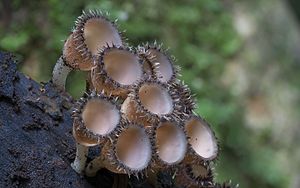Cookeina insititia
| Cookeina insititia | ||||||||||||
|---|---|---|---|---|---|---|---|---|---|---|---|---|

Cookeina insititia |
||||||||||||
| Systematics | ||||||||||||
|
||||||||||||
| Scientific name | ||||||||||||
| Cookeina insititia | ||||||||||||
| Berk. & MA Curtis , Kuntze |
Cookeina insititia is a hose fungus from the family of the cup-cup relatives .
features
Macroscopic features
The scattered to gregarious fruiting bodies , the apothecia , are 9-25 millimeters in size, although they are rarely larger than 10 millimeters. They are deeply bowl-shaped to goblet-shaped and white to dirty cream in color. The edge is sometimes flesh-colored, otherwise it is the same color as the rest of the fruiting body. Here there is white, stiff, triangularly compressed hair. The stem is also white to pale cream in color, but lighter than the actual fruiting body. It is 3 to 16 millimeters long and 1 to 2 millimeters thick. The layer surrounding the fruiting body, the excipulum , in turn consists of two distinguishable layers, the outer and the inner excipulum.
Microscopic features
The fruit layer is approximately 390 micrometers thick. The tubes are cylindrical, but taper conically at the base and each have 8 spores , which are arranged obliquely in a row. They are 400–453 × 12–16 micrometers in size and have thick walls. The spores are spindle-shaped, asymmetrical or curved with pointed ends, translucent , smooth, and grow to 36-47 × 8-16 micrometers in size. They have several drops of oil. The paraphyses are thread-like, septate , branched and also with irregular cross connections ( anastomosing ) and are 1–2 micrometers wide.
Ecology and diffusion
Cookeina insititia lives on dead, rotting wood. It has so far been found in China, Indonesia, the Philippines, Japan, and Samoa .
Systematics and taxonomy
Cookeina insititia was first described in 1858 by Miles Joseph Berkeley and Moses Ashley Curtis as Peziza insititia . Kuntze then placed the species in the genus Cookeina, which he newly established in 1891 . The synonym Microstoma insititia or the spelling Microstoma insititium , established in 1951 by Karel Bernard Boedijn , is sometimes still in use. Sometimes the species was also placed in its own genus, Boedijnopeziza .
etymology
The name insititia refers to the fruiting bodies that look like they have been planted. The generic name Cookeina honors the English mycologist Mordecai Cubitt Cooke .
swell
literature
- T. Iturriaga, DH Pfister: A monograph of the genus Cookeina (Ascomycota, Pezizales, Sarcoscyphaceae). In: Mycotaxon. Volume 95, 2006, pp. 137-180. ISSN 0093-4666
Individual evidence
- ^ A b c d e T. Iturriaga, DH Pfister: A monograph of the genus Cookeina (Ascomycota, Pezizales, Sarcoscyphaceae) . In: Mycotaxon . tape 95 , 2006, ISSN 0093-4666 , p. 137-180 ( (online) ).
- ↑ Cookeina insititia . In: Mycobank . Retrieved November 25, 2016 .
- ^ Mushroom books by Mordecai Cubitt Cooke . In: The Tintling . Retrieved November 25, 2016 .